I and the Bird Hits the Road
It's I and the Bird Number 137, and while some of the contributors were staying home, most of them were going somewhere - and sending back wonderful words and images
 .
.Greg at Greg Laden's Blog offers us some notes from up north:
That's how we identify golden eagles around here. They are not supposed to be here, so we remain in denial as long as we can. Nonetheless, once or twice a year we see one. We never see evidence of nesting, so they are probably just passing through on their way north or south, depending on the time of year.My own contribution is from my backyard, so to speak - the park near my office building.

It's October, and there are only a few things still blooming - yellow and purple daisies, those scrawny little daisy fleabanes, and the white joe-pye weed (or queen of the meadow). Birds of course are still around, though the summer visitors have left and the winter ones (juncos, mostly) haven't arrived yet. And there are a few butterflies left this late in October - some whites and sulphurs, and skippers, and the occasional brushfoot still. Here are a few shots from the park over the past week...Tony at Tyto Tony gets great shots of a heron in Australia

'Here's mud in your eye' perfect toast to Striated Heron (Butorides striata) yesterday on tidal mud where Herbert River meets Hinchinbrook Channel east of Ingham. Bird waited without movement for more than five minutes close to water-filled hole in mud.Dan at Nature Observances gets a good look at something new

"Ooh, quick get my camera, hurry hurry it's a peregrine" Not following my advice to myself to look well first with bins before shooting, I took several shots in the cloudy early morning lack of light. It was 30 feet away, enough for me with the naked eye to see all the identifying characteristics, and as my heart-rate slowed, I realized that bird flying away off the line was not a peregrine. I had an excellent look, and pulled out my field guide and confirmed it as a American Kestrel.Susannah at Wanderin' Weeta gives us some lovable coots:

I think coots are my favourite birds. Ridiculous birds, black-suited and bejewelled as if for a formal occasion, but wearing someone else's floppy bedroom slippers. Contortionists, splay-footed divers, splashing maniacs running on water to get up enough speed to fly, with a voice like a kid learning to play the kazoo, or alternately, like the creak of a ratcheted wrench on a rusty bolt, or sometimes the ploop! of a cork coming out of an old medicine bottle. And, in spite of all that, just plain cute.Amy at Magnificent Frigate Bird shares experiences of banding saw-whet owls, videos included:
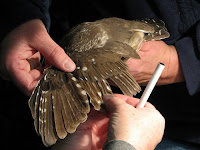
Last Saturday night Arthur and I visited the Sand Bluff Bird Observatory in Durand, Illinois. The banding station is open each weekend during spring and fall migration, and they band a huge number of birds – up to 4,000 per year. The station has been in operation since 1967 and has always been run by a team of dedicated volunteers. Visitors are welcome to observe songbird banding activities, which takes place during the day. Our visit on Saturday night was to see a special, nocturnal bird: the Saw-whet Owl.Nate at The Drinking Bird is County List Crazy:

In any case, with the successful twitch of the Connecticut Warbler, where I also found a handful of other good birds for the county, I finally found myself sitting in the first spot for Durham County. This was unexpected and sort of cool, until two days later when I got knocked back off that pedestal by one Robert Meehan (who also comments around these parts as BirdtrainerRobert). Rather than accept my demotion with the good graces you might expect from any reasonable individual, I decided to put myself on top for good, so this past weekend I went out for the first time to specifically find some birds in a specific county. This is the dawning of a new era for The Drinking Bird. One no doubt defined by repetition, naval-gazing, and mind-numbing minutia. Get ready!Robert at Birding is fun! shows us how much more fun it is to help another birder:

My friend Jason, in Idaho, has been getting back into birding this year after a couple decades off. We've been Boy Scout leaders together this last year so our campouts have included a little element of birding. I have been a bad birding influence on him, like a drug dealer. Being home in the Boise area this weekend, Jason and I determined to get out and do a little birding together. The target bird was a Hooded Merganser, the male being one of the most showy and beautiful wintering waterfowl in this area and one that Jason has never seen before. I was happy to see a recent report of a Hoody on eBird in a nearby pond, so I felt our chances were good. Jason and I set out with a couple hours planned for a whirlwind tour of about two dozen Eagle, Idaho area ponds near the Boise River.
 Joan from Anybody Seen My Focus? gets some nice shots of woodpeckers.
Joan from Anybody Seen My Focus? gets some nice shots of woodpeckers.The berries have ripened and a lot of birds are more visible than usual. I encountered these two birds in an open area along the trail south of the Fishing Area (segment 13) last week. They were up in trees – twenty to thirty feet above the ground and just about as far away.Jan at Jan Axel's Blog goes birding on the savannas in Panama - very successfully, too.
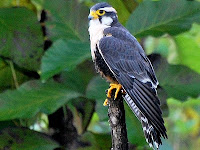
It was quite foggy, but anyway I found most of the typical birds of this habitat, and more. I noticed that many of the rice fields were flooded, attracting many birds, both residents and migrants. I saw (and photographed) most of the birds while seated in my car, using it as a hide.Corey from 10,000 Birds went birding in Ft Tilden
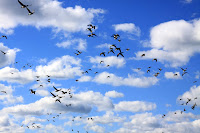
The northwest winds were blowing hard and a trickle of birds were coming back to land after having been blown out to sea while migrating overnight. Most of the birds that we spotted during the morning in the hedges, bushes, and other assorted cover were Yellow-rumped Warblers, White-throated Sparrows, and Eastern Phoebes. Other sparrow species were around in smaller numbers and an occasional wren, cardinal, or kinglet enlivened our search for hoped-for rarities but the big three were dominating our fields of view.John from my neck of the woods, A D.C. Birding Blog, went to Great Swamp and got some gorgeous shots

Yesterday I was at the Great Swamp NWR on a cool and blustery day. Despite the unfavorable weather for bird observation, a lot of people were on the boardwalk trails, most of them gathered in two tour groups. The wind kept much of the bird activity out of view, but there were still birds to be seen. Winter residents are arriving in good numbers now.Pat from Costa Rica Living and Birding also took a trip, to Kiri Lodge:
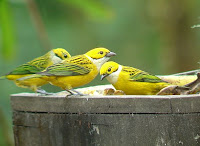
The Kiri Lodge people are friendly enough to still serve you with a smile even if you don’t like trout and opt for fried chicken or a beef “casado” (a “casado” is an all purpose standard, tasty meal that usually consists of rice, beans, plantain, salad, vegetable, and beef, chicken, or fish). For the birder, of far more importance than their penchant for trout is their friendly attitude about birds. They demonstrate this with hummingbird feeders and a fantastic bird-feeding table.James from Coyote Mercury went to Central Park:

A guidebook in the hotel suggested that The Ramble would be a good place for birding since it’s the wildest corner of Central Park, featuring landscapes similar to what might have existed in Manhattan before Europeans came. I don’t know if that’s true or not, but the area certainly was wilder than the rest of the park and to my surprise the birds most common in the rest of the city—pigeons, starlings, and house sparrows—were virtually absent in The Ramble.Amber at the Birder's Lounge was in the right wrong place in Oklahoma:

I pulled to the side of the gravel road, parked, and watched a large flock of mostly Red-winged Blackbirds (Agelaius phoeniceus) moving amongst the abundant roadside vegetation. Swaths of sunflowers five to six feet tall lined the roadway, with expansive, flat, agricultural fields stretching out behind them. The flock bobbed for seeds, perched on stems and flowerheads.Johnny Nutcase at Count Your Chicken! We're Taking Over! saw a beautiful bird in Black Canyon:

This lovely lady is a Dusky Grouse (Dendragapus obscurus), formerly known as the Blue Grouse. These guys have a fairly restricted range in some of the Western States up towards Alberta. I saw a small handful on my trip, but this one was awfully generous and let me take some pictures. I found her while I was wandering around just after sunrise in Black Canyon of the Gunnison National Park.Finally, GrrlScientist at Punctuated Equilibrium takes us into the realms of science as she looks at what's up with parrot feathers:
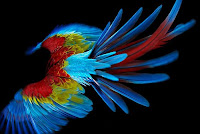
But among birds, the parrots are unique: their bright reds, oranges and yellows are not derived from dietary carotenoids. Unlike any other group of birds, parrots synthesize their own red, orange and yellow pigments, which were named "psittacofulvins" in honor of their avian creators. Interestingly, these lipid-soluble pigments are found nowhere else; not in other birds, not in plants, nor even in plankton.





























3 Comments:
-
At 9:38 PM, October 28, 2010
 JSK had this to say...
JSK had this to say...
-
-
At 9:39 PM, October 28, 2010
 Jan Axel & Gloriela had this to say...
Jan Axel & Gloriela had this to say...
-
-
At 1:39 AM, October 30, 2010
 Tyto Tony had this to say...
Tyto Tony had this to say...
-
-
<-- Older Post ^ Home Newer Post -->Great edition and posts! Thanks for hosting.
Great collection of posts, I'm on my way of reading them all!
Entertaining mix of posts. Well done and thanks for hosting.
Post a Comment
Subscribe to Post Comments [Atom]